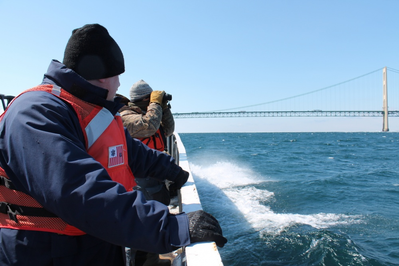Response to Mackinac Spill Continues
A U.S. Coast Guard marine science technician and an environmental quality analyst for Michigan's Department of Environmental Quality surveyed the Straits of Mackinac onboard a vessel Thursday. The responders did not identify any mineral oil sheens, signs of pollution, or adverse impacts to the environment or wildlife.
Earlier this week, hundreds of gallons of mineral oil has been released from a leaking underwater utility line in Michigan’s Straits of Mackinac.
Members of the U.S. Department of Agriculture are deploying to the scene to survey the area for any wildlife that may be affected by the mineral oil spill.
The National Oceanic and Atmospheric Administration’s new calculation for the trajectory of the spill is to the east and northeast of the utility line, due to changing weather conditions. The entities responsible for the operation of the water intakes in the surrounding communities have been notified of the change in trajectory, however there is still low risk to drinking water and the environment due to the product’s low toxicity and dilution in the waterway. The mineral oil is not known to be leaking from the source at this time, and the estimated amount of oil spilled remains at 600 gallons.
In the mineral oil, there is a dielectric fluid that contains a benzene compound.
“The benzene molecule is known to cause cancer but these larger chemicals (benzene compounds in the dielectric fluid) have not been classified as causing cancer," said Edward Primeau, an industrial hygienist from the Coast Guard Atlantic Strike Team.
Crews continue to extract the oil from the affected two utility lines.













